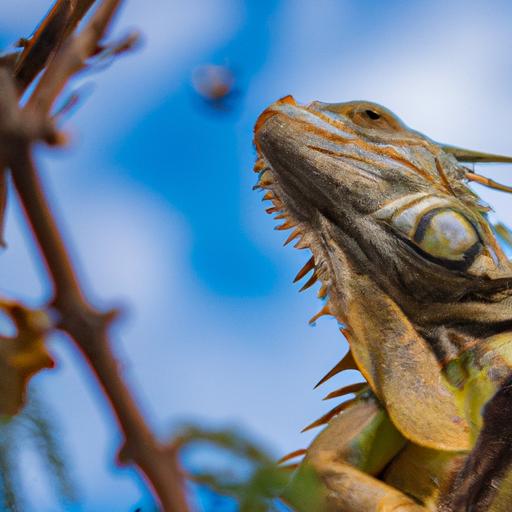
Discover the truth behind iguanas in cold weather. do iguanas freeze and come back to life? Learn how these reptiles cope with low temperatures and the risks involved.
Have you ever wondered what happens to iguanas when the temperature drops? As a pet owner or someone interested in these fascinating creatures, you may be curious about whether iguanas can survive being frozen. In this article, we’ll explore the topic of whether iguanas freeze and come back to life.
Understanding Iguanas
Habitat and Behavior
Iguanas are captivating creatures that call the tropical regions of Central and South America home. They are primarily arboreal, meaning they live in trees and other high places. With their long tails, sharp claws, and prominent dewlaps, iguanas showcase a distinctive appearance. As herbivores, they feast on a variety of plants and fruits.
Temperature Regulation
Critical to an iguana’s behavior is its ability to regulate body temperature. Being cold-blooded, iguanas rely on external heat sources to warm their bodies. They bask in the sun to absorb heat and seek shade when they become too warm. Iguanas also engage in thermoregulation behaviors like burrowing underground or finding shade to maintain their body temperature.
Importance of Temperature Control
Temperature control is vital for iguanas due to their high sensitivity to temperature changes. Being exposed to excessively high or low temperatures can lead to illness or even death. As responsible iguana owners, it is important to provide them with adequate heat sources and a suitable environment to prevent serious health problems.
Freezing and Reanimation
What is Freezing and Reanimation?
Freezing and reanimation is a survival mechanism exhibited by iguanas when exposed to extremely cold temperatures. This phenomenon allows them to conserve energy and avoid death in harsh environments.
The Process of Freezing and Reanimation in Iguanas
When temperatures drop, iguanas become lethargic, and their heart rate slows down. As the temperature continues to decrease, their body functions gradually shut down, leading them into a state of suspended animation. During this time, their body temperature can drop to as low as 40 degrees Fahrenheit, which is below their normal range.
Once the temperature starts to rise, the iguanas begin to thaw out. Their heart rate increases, and their body functions gradually return to normal. This process of reanimation can take several hours, during which time the iguanas may appear lifeless. However, as their body temperature rises, they regain activity and come back to life.
Scientific Evidence for Freezing and Reanimation in Iguanas
Scientists have observed and documented the phenomenon of iguanas freezing and coming back to life. A study published in the Journal of Experimental Zoology found that iguanas can survive temperatures as low as 35 degrees Fahrenheit for up to 18 hours. This research provides evidence that iguanas indeed have the ability to freeze and reanimate, enabling them to survive in cold environments.
Survival Adaptations
Have you ever wondered how iguanas manage to survive being frozen? These reptiles possess interesting survival adaptations that allow them to endure even the coldest of temperatures. Let’s take a closer look.
Survival Adaptations that Allow Iguanas to Freeze and Come Back to Life
One of the most captivating survival adaptations of iguanas is their ability to slow down their metabolism. When temperatures become too cold, iguanas can enter a state of torpor, which slows down their bodily functions and helps them conserve energy. In this state, iguanas can appear completely immobile and frozen, but they are still alive. Once the temperatures warm up, they thaw out and become active again.
Another noteworthy survival adaptation of iguanas is their ability to store fat in their tails. This stored fat serves as an energy source when food is scarce or temperatures drop, enabling iguanas to conserve energy and survive for longer periods without eating.
How These Adaptations Help Iguanas Survive in Cold Environments
These survival adaptations are crucial for iguanas to weather cold environments successfully. By slowing down their metabolism and conserving energy, iguanas can endure the winter months when food is scarce. Additionally, by storing fat in their tails, iguanas can survive for extended periods without eating.
Examples of Other Animals with Similar Survival Adaptations
Iguanas are not the only animals that possess survival adaptations allowing them to thrive in extreme conditions. For example, certain species of frogs can freeze solid and survive in a state of suspended animation until temperatures warm up. Moreover, some species of birds enter a state of torpor during long migrations to conserve energy. These remarkable adaptations among animals demonstrate how they have evolved to survive in their respective environments.
Conclusion
In conclusion, iguanas are extraordinary creatures that possess the ability to adapt to a wide array of environments. When faced with cold weather, iguanas have developed various strategies to cope with temperature fluctuations. They can reduce their metabolic rate, seek warm spots, and bask in the sun to raise their body temperature.
While iguanas can survive in cold weather, there are still risks associated with exposure to low temperatures. It is crucial for iguana owners to take precautions and provide a warm, safe environment for their pets during the winter months.
So, do iguanas freeze and come back to life? While it may appear that iguanas become lethargic and frozen in response to cold temperatures, they do not actually freeze and come back to life. Instead, they have evolved unique survival adaptations that allow them to slow down their metabolism and conserve energy until warmer temperatures return.
At iguanafacts.com, we hope that this article has shed some light on the fascinating world of iguanas and their behavior in cold weather. By gaining a deeper understanding of these amazing creatures, we can all contribute to ensuring their health and well-being.




